Arizona is home to tens of caterpillar species. Some of these are seen every year while others are seen every few years, depending on weather and rainfall.
Arizona is among the states where caterpillars also come to overwinter.
Many types of caterpillars in the state are found around homes and gardens attracted to lawn humidity.
Table of Contents
Are Arizona Caterpillars Poisonous?
No caterpillars in Arizona are poisonous. Some species take on the appearance of bird droppings while others have vivid red or pink coloring to appear dangerous.
In reality, none of these species are poisonous. It’s still best not to handle the caterpillars with spikes as a few of them exist around the state.
Caterpillars in Arizona
The following species of caterpillars in Arizona can be seen almost every year, sometimes even multiple times per year as multi-brood species are common across the state.
1. White-lined Sphinx Caterpillar
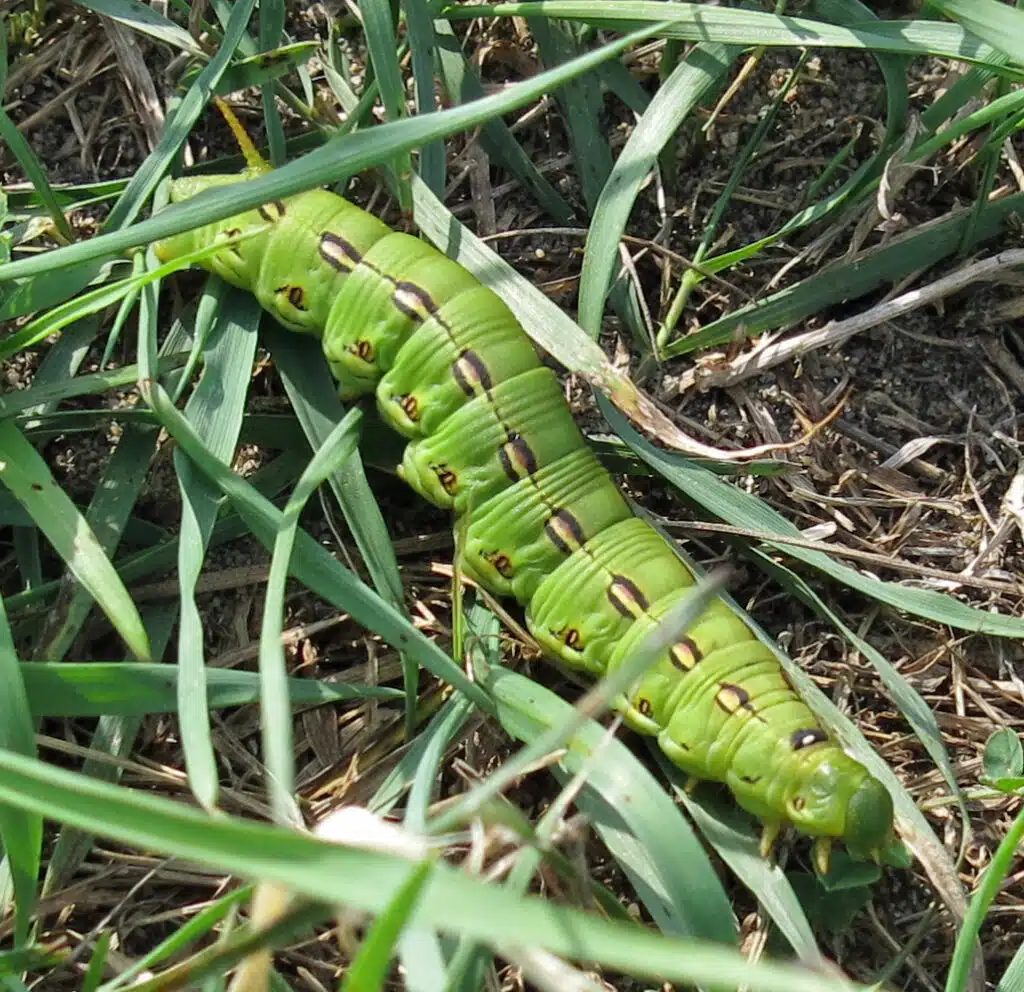
White-liked Sphinx Caterpillar (Hyles lineata) is a common species that loves the warm Arizona climate.
This caterpillar is characterized by contrasting colors but it also comes in different base colors.
The Green base color is specific to the species. It may also come in a yellow base color.
The caterpillar has black stripes when yellow and black spots with orange and yellow central areas when green.
This is a species not tied to a specific host plant.
It can be found both on trees and plants. Willows and apple trees are among their most common hosts.
Umbrellaworts are among its plant hosts. In some Arizona gardens, White-lined Sphinx Caterpillars are found on tomatoes.
2. Queen Caterpillar

Some of the most common caterpillars in Arizona and Southern US states is the Queen Caterpillar (Danaus gilippus).
This species resembles the Monarch caterpillar but it appears darker.
Queen Caterpillars go through various color changes as they go through instars or growth stages.
There are 5 instars this species goes through until pupation. It has white, black, brown, and yellow colors in its final growth stage.
A white body with black crossbands that feature yellow decoration is specific to this species.
Different plants are the host of this species in the state.
It feeds on butterflyweed and bloodflower.
Other common hosts of the caterpillar include different types of milkweed such as Caribbean Milkweed and dogbane.
3. American Snout Caterpillar
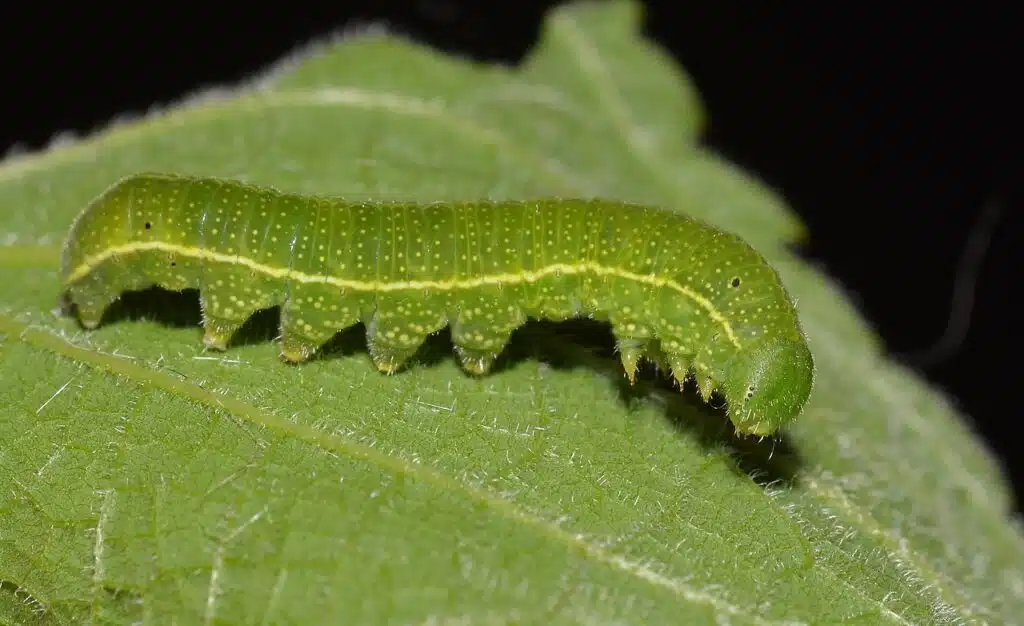
Some of the smallest caterpillars in the state are American Snout Caterpillars (Libytheana carinenta).
This species grows to a maximum size of 1 inch.
A green or bright green color is specific to this species. Both its body and its prolegs are green.
American Snout Caterpillars feed on sugarberry tree leaves.
1 to 2 generations of the species are seen each year. Southern areas of the state might host a couple of generations.
This species maintains its green coloring into its pupal stage.
4. Pipevine Swallowtail Caterpillar
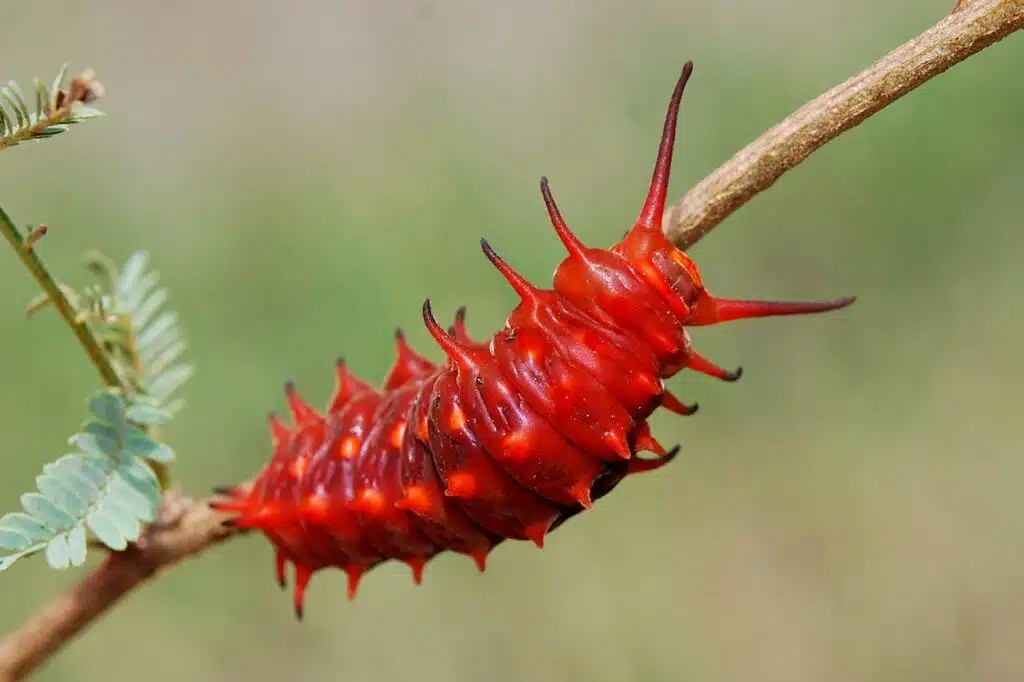
A common species across all areas of Arizona (except its Northern parts) is the Pipevine Swallowtail Caterpillar (Battus philenor).
This species is characterized by various shades of brown across all of its growth stages.
Pipevine Swallowtail Caterpillars are light brown initially to become dark brown in their last instar.
Short tubercles covering its body become long tubercles which make the species stand out.
Some of its tubercles have the same color as its brown body while others become bright orange-red.
The pupae of the species are green or brown as well.
Pipevines are the main hosts of the species.
This caterpillar eventually becomes a blue and black butterfly. Pipevine Swallowtail Butterflies are some of the most common iridescent blue butterflies in the state.
5. Painted Lady Caterpillar
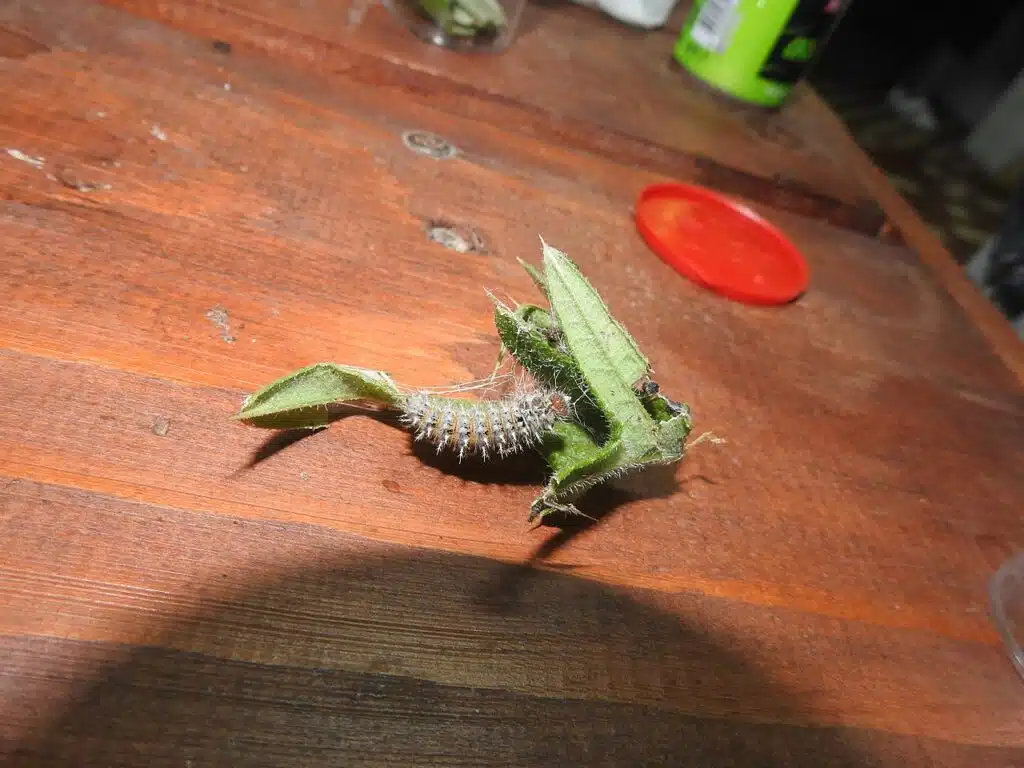
Painted Lady Caterpillars (Vanessa cardui) are a species of black, white, brown, and yellow caterpillars.
It shows yellow crossbands, a black base color, and white dots across the body. White, tan, and black spike-like hairs cover its body.
Painted Lady Butterflies are among the few species in Arizona known for their long-distance migration.
This species comes to the state to lay eggs and overwinter.
It chooses various species of asters as its hosts.
Plume thistles are among the common species this caterpillar is seen on.
6. Sleepy Orange Caterpillar
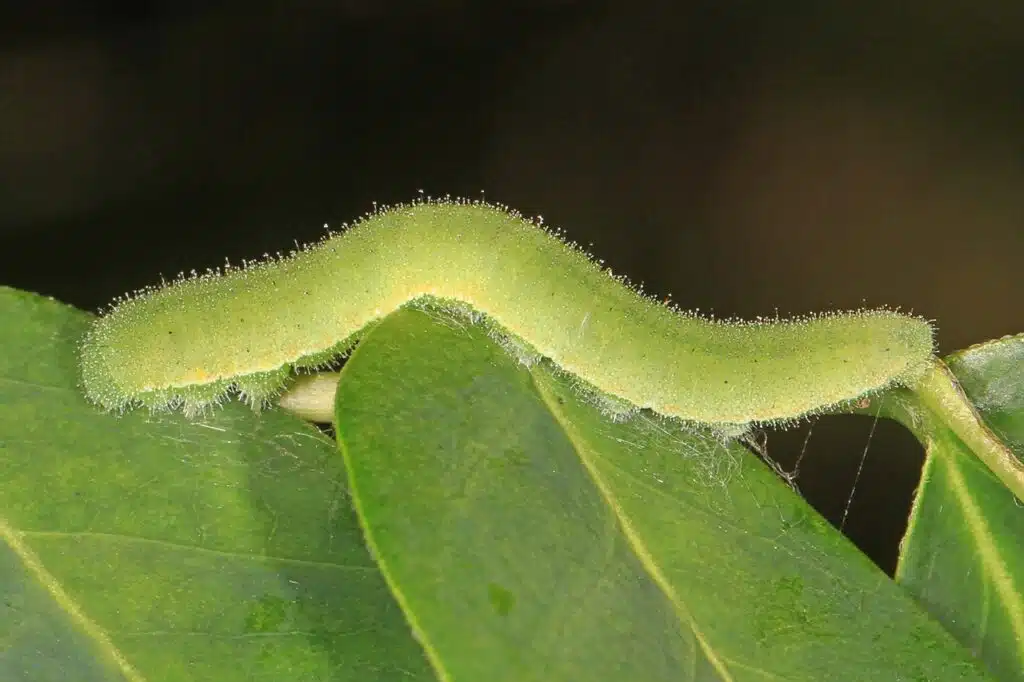
Sleepy Orange Caterpillars (Abaeis nicippe) have a base green color which becomes lighter as it grows.
Green is also the base color the eggs of the species have.
This caterpillar is also covered in scarce hairs which aren’t poisonous.
Pea plants in Arizona are the main host of the species. Sleepy Orange butterflies move on to other plants as adults for nectar, such as shepherd’s needle.
Partridge peas are some of the most common species this caterpillar feeds on.
As with Painted Lady Butterflies, Sleepy Orange Butterflies also migrate to Southern states such as Arizona to overwinter.
7. Gray Hairstreak Caterpillar

Gray Hairstreak Caterpillars (Strymon melinus) have bright colors looking completely different from the dark emerged butterfly of the species.
White, cream, and pink are the atypical colors of the Gray Hairstreak Caterpillar.
These colors might serve as a potential threat to predators as they may make the species look poisonous.
Pea family plants are the legume host of the Gray Hairstreak Caterpillar.
Adult Gray Hairstreak Butterflies move on to nectar-rich plants such as dogbane.
One particularity of the feeding habits of these caterpillars includes their capacity to eat flowers.
They only eat host plant leaves in the last instars.
8. Arizona Sister Caterpillar
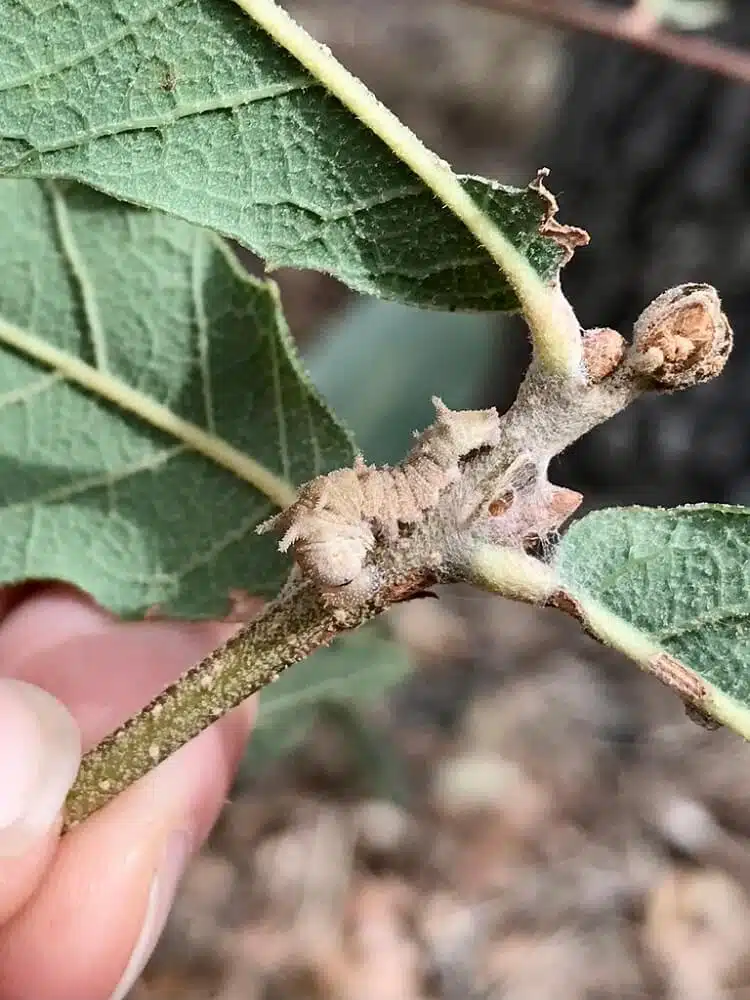
A native species in Arizona, this caterpillar (Adelpha eulalia) is known to have an irregular shape and even look like a twig.
It has brown and grey coloring with brown spikes which keep predatory wasps away.
This species is seen as an oak pest in the case of rare outbreaks.
Small regional differences are seen in the numbers of Arizona Sister Caterpillars depending on their location within the state.
Up to 4 broods of the species are seen in Southern parts of the state compared to 2 broods in other regions of Arizona.
Once an adult, this species feeds on fruits and flowers, and leave oak tree leaves behind.
9. Dainty Sulphur Caterpillar
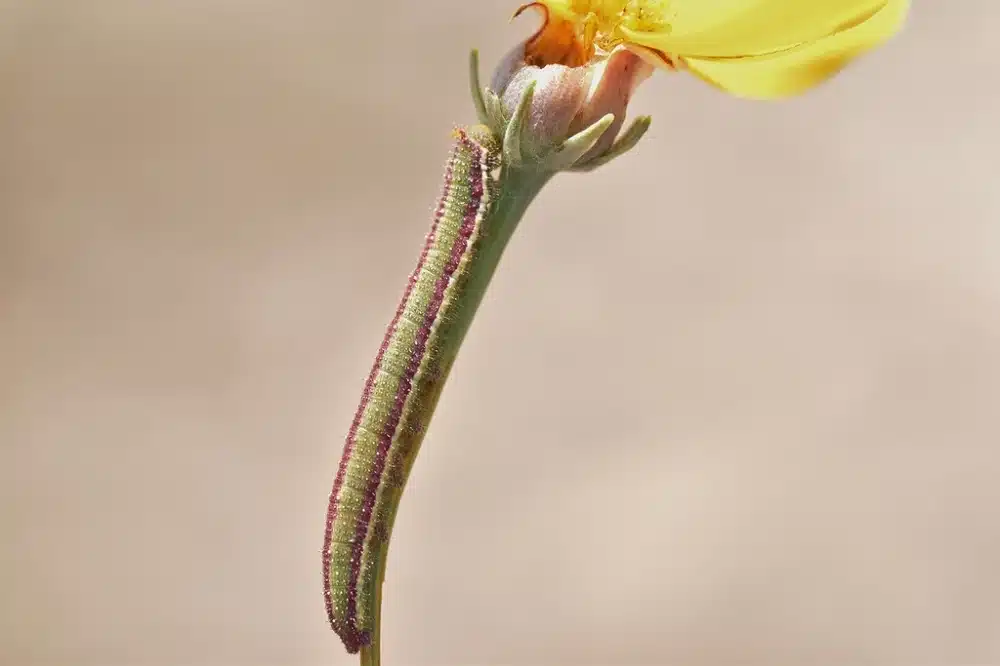
Dainty Sulphur Caterpillars (Nathalis iole) begin life as yellow eggs. They become green caterpillars to later turn into green and yellow pupas.
Different types of asters are the hosts of these caterpillars.
They grow on shepherd’s needles and different types of marigolds.
Dainty Sulphur Caterpillars are among the few species which share the same host plants with adults.
You can find both caterpillars and adults of the species in areas with grass and plenty of sunlight around the state which represent ideal habitats for host asters.
10. Checkered White Caterpillar
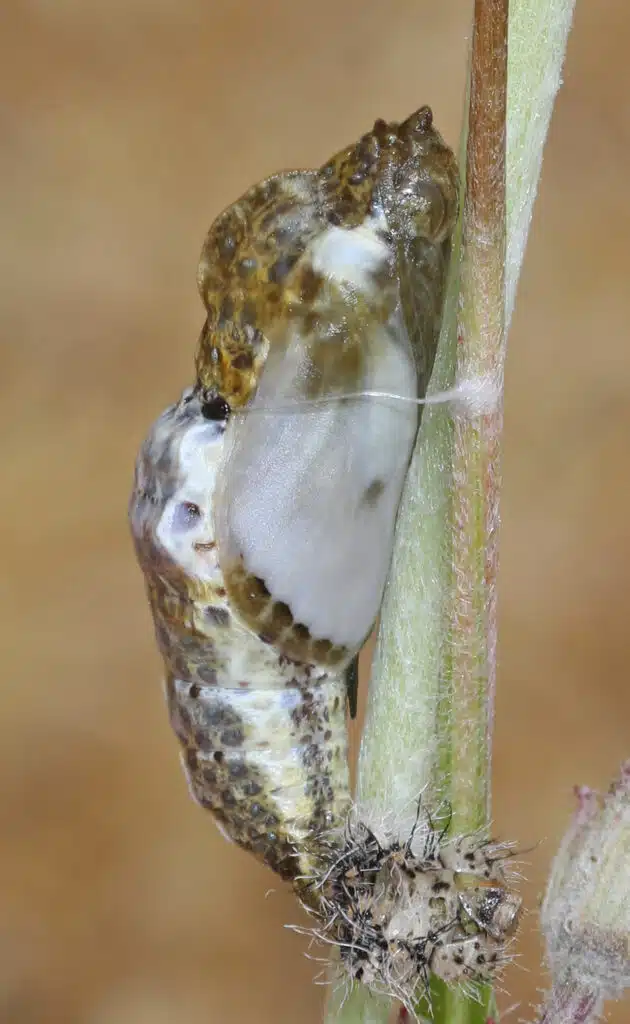
Checkered White Caterpillars (Pontia protodice) are marked by yellow coloring with black contrasting secondary colors through various life stages.
This species starts life as a yellow egg. It later turns into a black and yellow caterpillar.
Alternating black and yellow stripes are specific to this species. Tiny black spots are further distinguishable on the yellow parts of its body.
Checkered White Caterpillars then turn into rare blue-gray pupas.
Herbs are the common hosts of the species.
A preference towards pepperweed mustard herbs is specific to this species.
Its impact on cultivated mustard makes insecticide one of the go-to solutions against these caterpillars.
11. Monarch Caterpillar
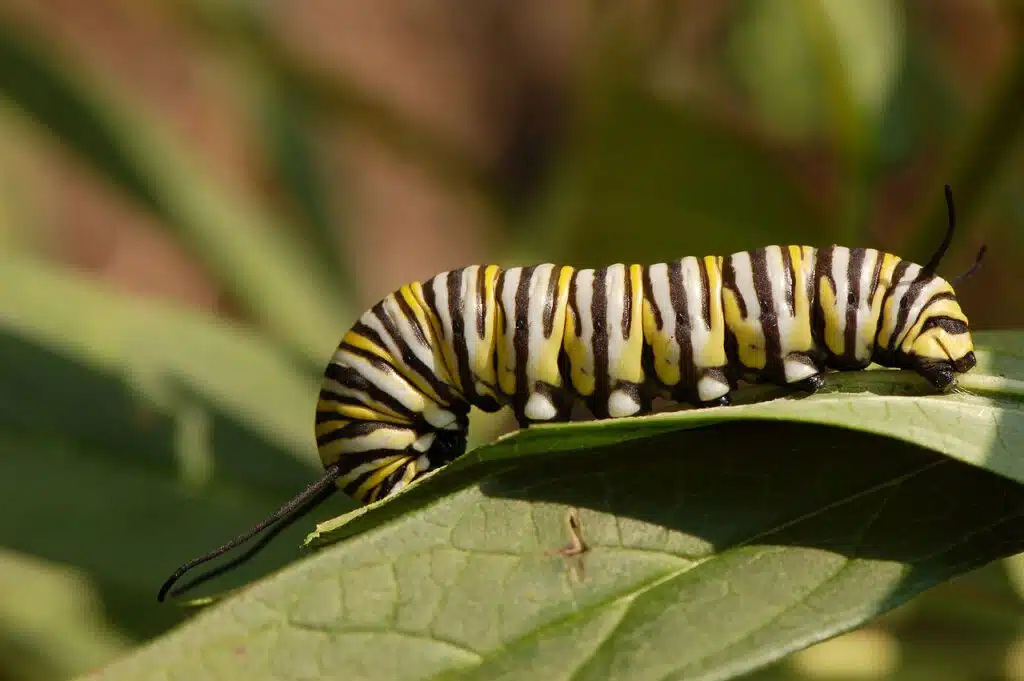
A pale green egg at first, the Monarch Caterpillar (Danaus plexippus) goes through 5 growth stages until reaching its final pupal stage.
This species bears a physical resemblance to Queen Caterpillars.
Alternating black, white, and yellow bands cover the body of this species with black antennae.
This caterpillar grows to a size of at least 1.7 inches.
Many types of wild and cultivated ornamental plants are the hosts of the species.
Milkweeds tend to be the preferred host of the caterpillar.
As with other species, White milkweed and Caribbean milkweed are among their most common plant hosts.
The type of hosts this species has dictates its migration preferences.
Caterpillars feeding on certain types of milkweed such as tropical milkweed are less likely to migrate to other hosts.
12. Gray Buckeye Caterpillar
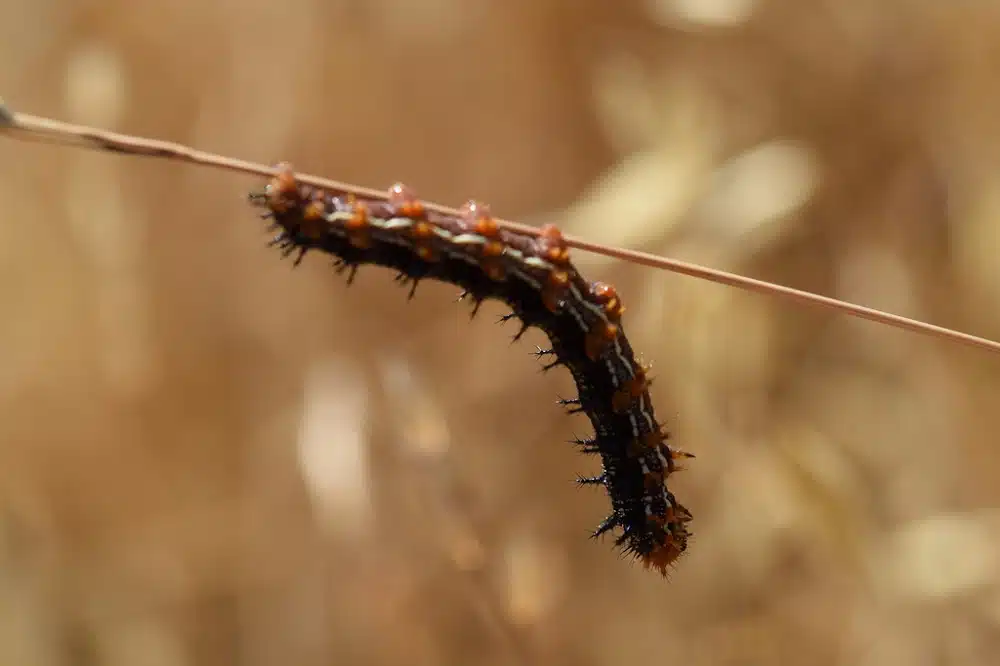
A dark red-brown color is specific to the Gray Buckeye Caterpillar (Junonia grisea).
This species has red undertones as a caterpillar to become brown as a butterfly.
Black and white stripes cover the dorsal side of the species, together with black spikes.
This caterpillar also tends to become partially black on its dorsal side in its last instar.
Seen across various plants and herbs, the Gray Buckeye Caterpillar may also come with orange or light brown prolegs.
13. Gulf Fritillary Caterpillar
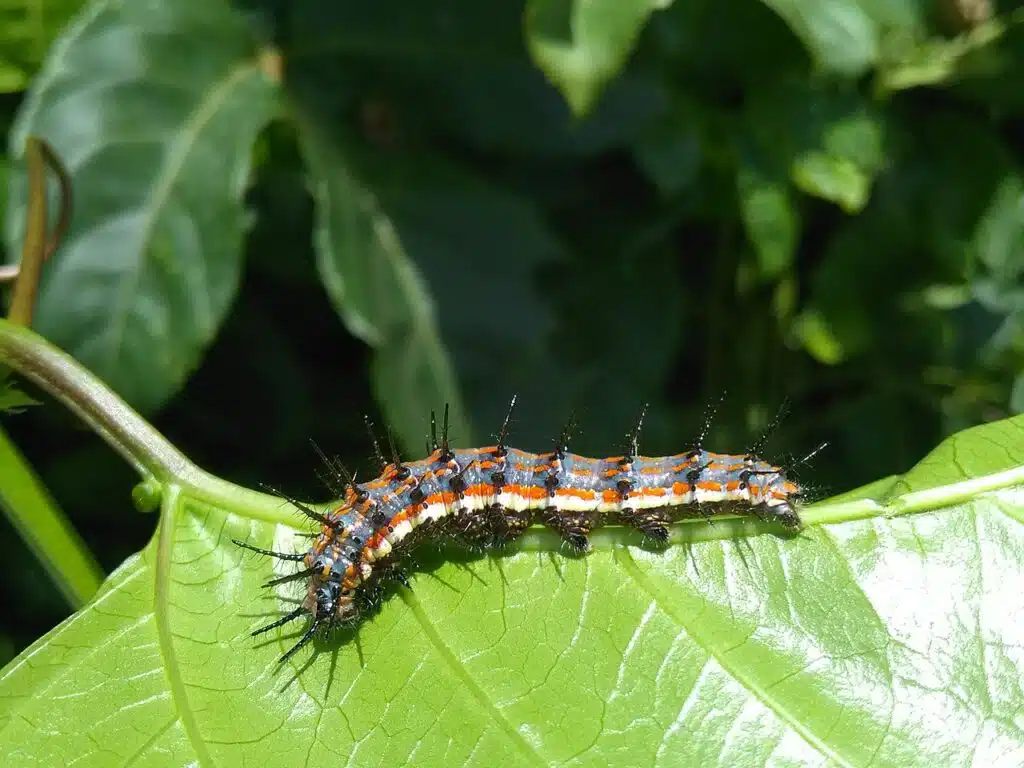
An orange color with black stripes and black spines across the body is specific to the Gulf Fritillary Caterpillar (Dione vanillae).
As a contrasting species, these caterpillars also show long black spines to further protect themselves from predators.
5 growth stages or instars are specific to The Gulf Fritillary Caterpillar.
These growth stages are marked by different timeframes and different feeding habits.
Leaf margins are preferred in the first instars with the capacity to move along to other leaves in the last instars to feed on softer leaf margins.
The average lifespan of the Gulf Fritillary Caterpillar is 2 weeks.
The species then spend at least a week in its pupal stage before emerging as a butterfly.
14. Rustic Sphinx Caterpillar
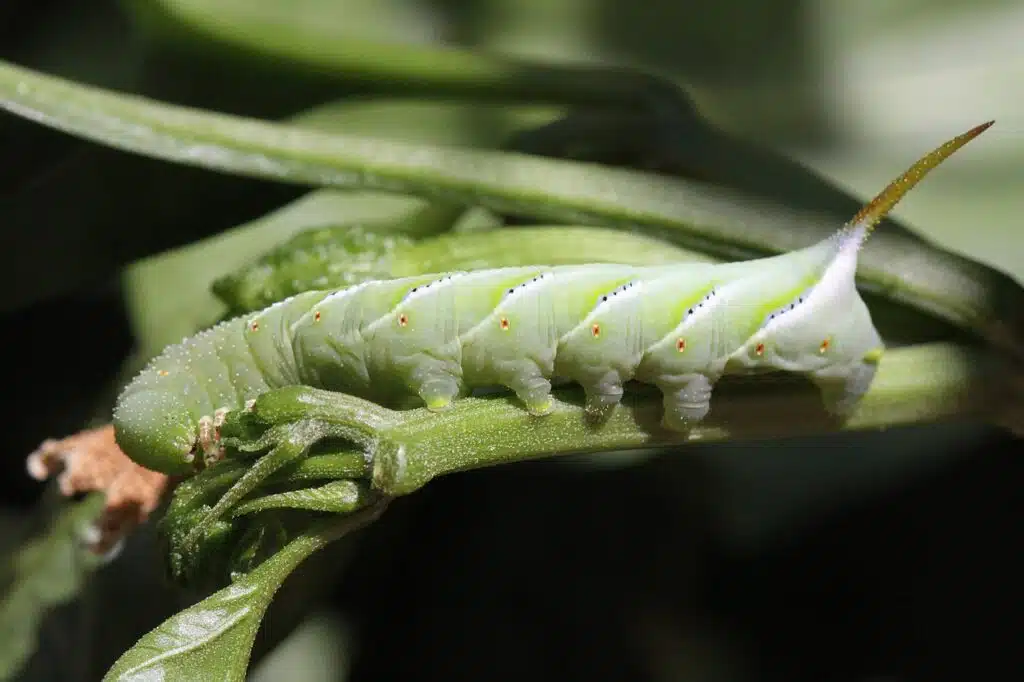
This type of caterpillar (Manduca rustica) is the only species in the state named after its feeding position.
The sphinx position involves a raised head and a lowered body, similar to ancient sphinxes.
Caterpillars of the species have bright green coloring and feature yellow diagonal stripes along its body.
The Rustic Sphinx Caterpillars grow and feed on various ornamental plants. Species such as gardenia and jasmine are often hosts for the species.
Caterpillars of this family continue feeding on these plants in the 1-4 instar stage to drop to the ground for pupation in the 5th and final instar.
While not a pest in Arizona, The Rustic Sphinx Caterpillar can always become a pest of olives and sesame.
15. Cloudless Sulphur Caterpillar
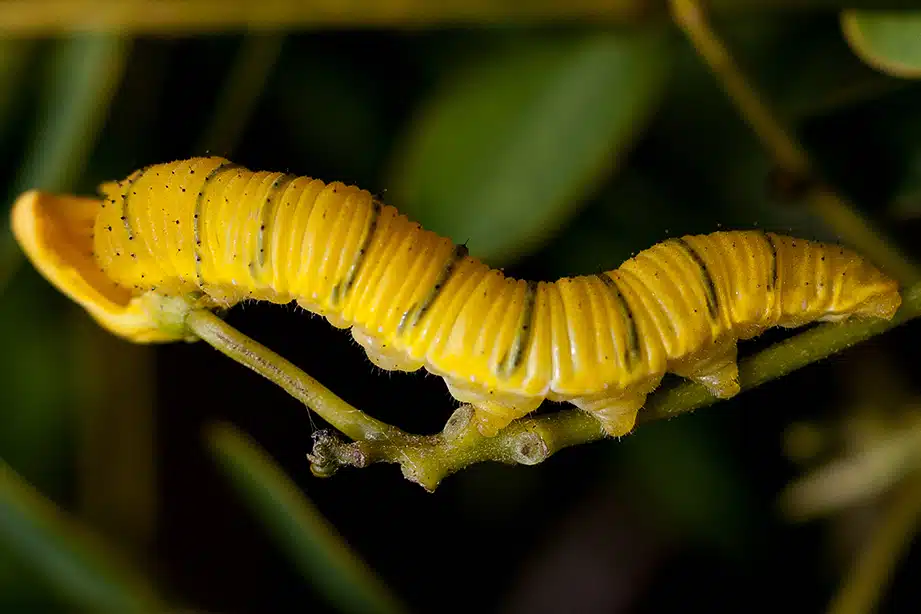
Cloudless Sulphur Caterpillars (Phoebis sennae) are a species that eat both the flowers and the leaves of their host plant.
Multiple plants in the pea family as well as coffeeweed are the main hosts of the species.
These herbs can be consumed by the caterpillars completely.
Chemical solutions aren’t needed against these caterpillars. If you grow pea plants such as sensitive peas in your garden you can remove the caterpillars by hand.
Species identification is based on the green color that turns yellow of the caterpillar.
This species has a green body with yellow lateral stripes to become yellow with black crossbands in its later growth stages.
As a migratory species, Cloudless Sulphurs can be found in any habitat with pea plants and plants in the senna family such as the candlestick plant.
16. Variegated Fritillary Caterpillar
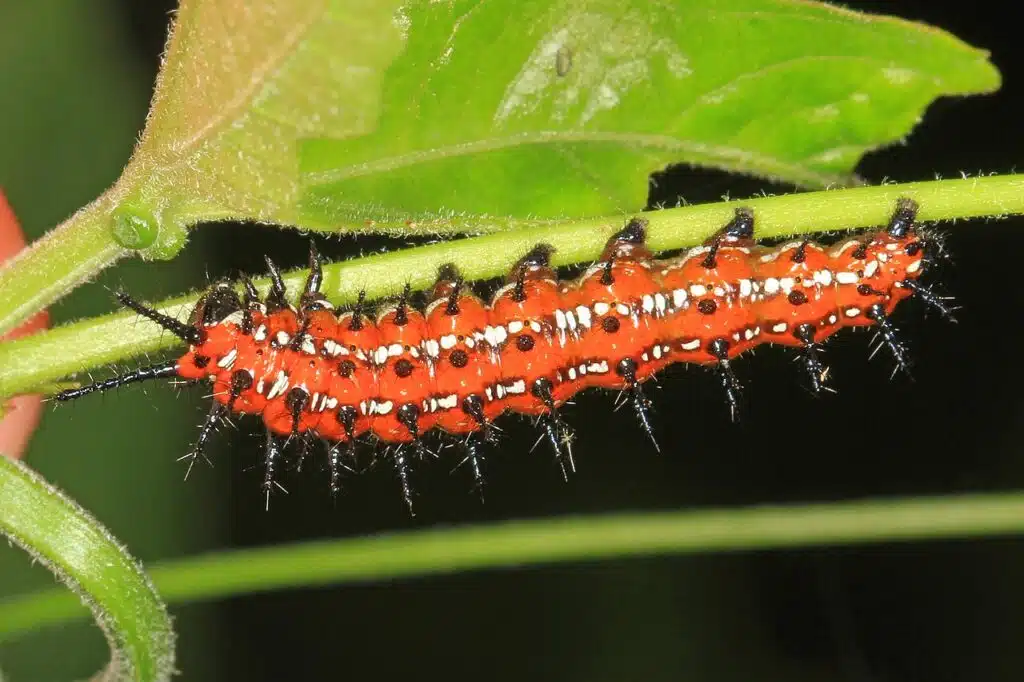
Alfalfa, used as crop cover is one of the most impacted plants of the Variegated Fritillary Caterpillar (Euptoieta claudia).
This species is also spotted on passionflowers, violets, common asters, dogbane, and red clover.
Its pest status is not the most important in the state as outbreaks are rare.
One of the host plants of the species that grow next to homes and gardens is plantain. This means this caterpillar is also found in suburban areas.
You can identify the species by its brown, white, and black bands.
Black spines and black antennae cover its contrasting body.
This caterpillar undergoes a complete metamorphosis as it turns into a white chrysalis to then turns into a brown and black butterfly.
17. Western Giant Swallowtail Caterpillar
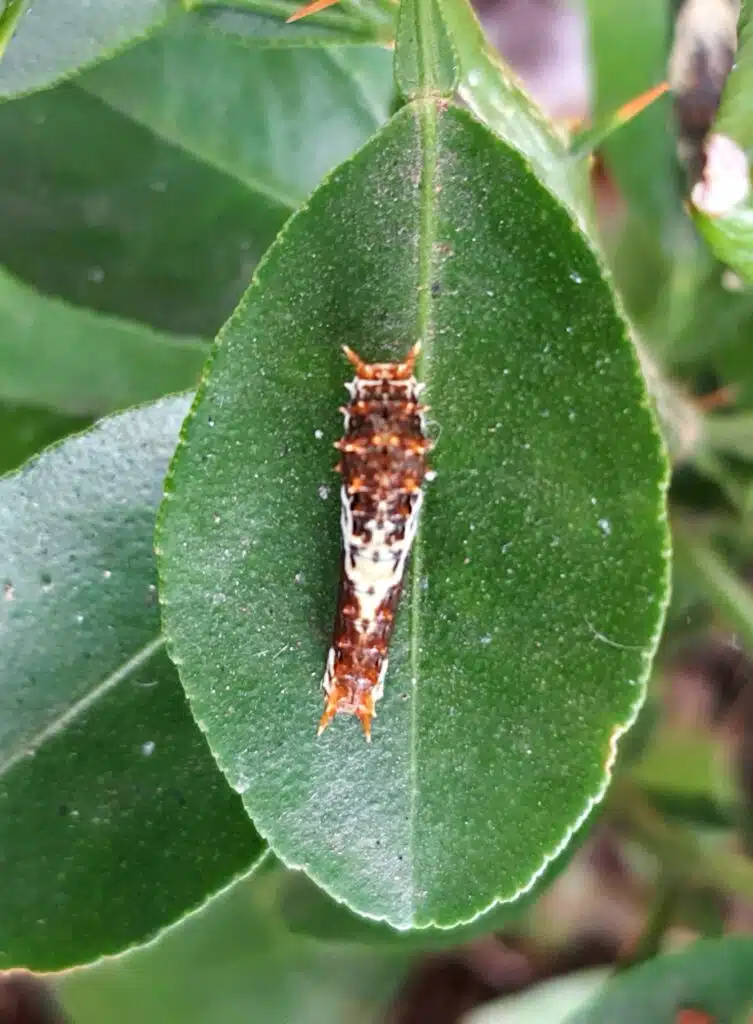
Spotted on citruses, Western Giant Swallowtail Caterpillars (Papilio rumiko) go through 5 instars or growth stages.
All of these stages are characterized by dark and bright colors that mimic bird droppings, as an attempt of the species to keep predators away.
Brown is the base color of the caterpillar through all of its growth stages.
Brown and yellow at first, this caterpillar becomes brown and white to eventually become brown and gray in its 5th and final instar.
Gray and brown or gray and white color combinations are further seen on its chrysalis.
A native to Arizona and Texas, this species has been spreading its habitat West toward California over the past few years.
18. Bordered Patch Caterpillar
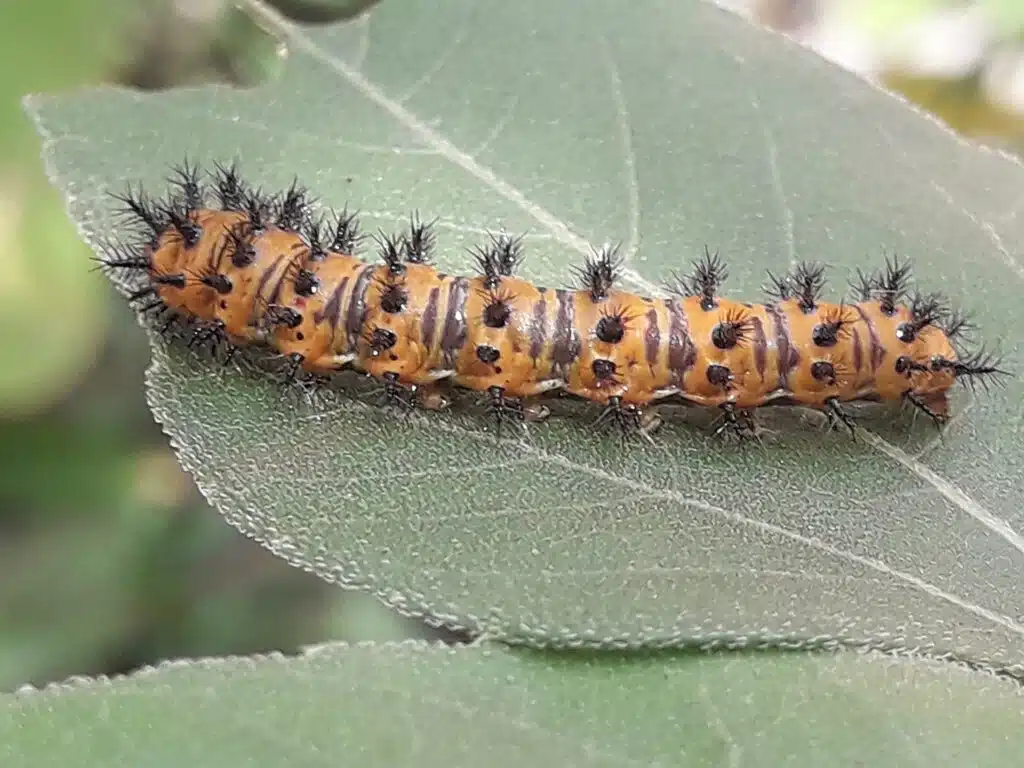
Bordered Patch Caterpillars (Chlosyne lacinia) are among the darkest species in the state. These caterpillars grow into a black color in their late growth stages.
Black spikes also cover their body in rows.
Multiple types of hosts are recorded for the Bordered Patch Caterpillar. These hosts include many flowers in the sunflower family.
While not a major pest, the caterpillar can damage decorative sunflowers grown in gardens.
The damages are more likely to be caused by late-instar caterpillars over early-instar caterpillars.
Only the underside of sunflower leaves is eaten by the young caterpillars while older caterpillars eat entire leaves and even the stems of their host plants in the sunflower family.
19. Southern Dogface Caterpillar
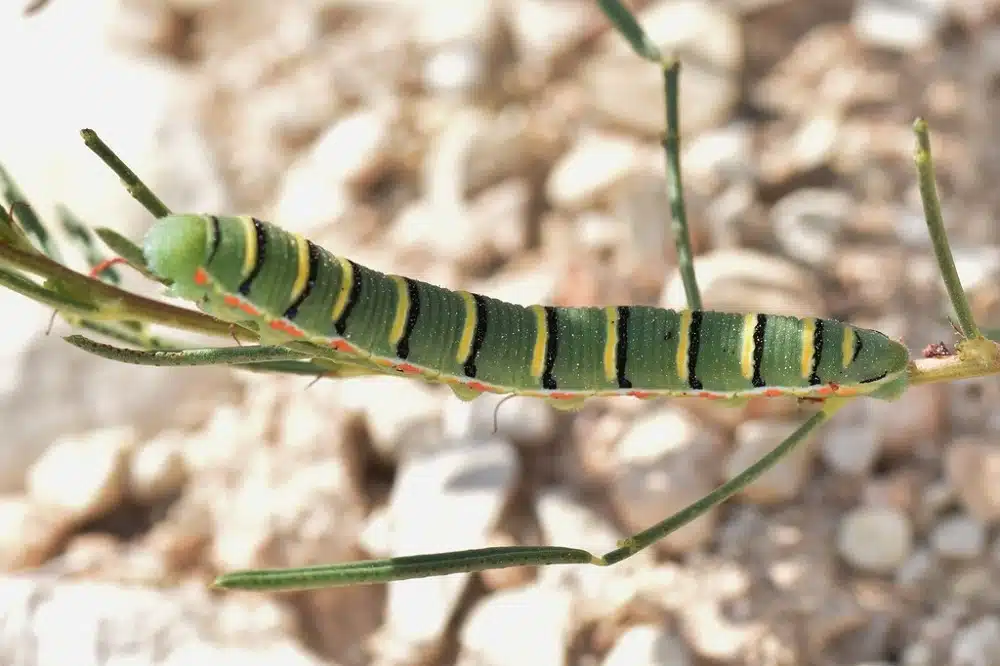
The longest lifecycle of the Southern Dogface (Zerene cesonia) is in its caterpillar stage.
This species spends anywhere between 2 to 4 weeks growing as a caterpillar to only survive around 10 days as a butterfly.
A base green color is characteristic of the Southern Dogface Caterpillar.
Joined black and yellow crossbands are seen on the dorsal side of this species.
Southern Dogface Caterpillars exclusively feed on the small leaves of their host plants.
They choose small plants such as dogbane and alfalfa as their hosts.
Southern Dogface butterflies migrate South where they lay eggs that become caterpillars.
Adult butterflies feed on similar dogbane and alfalfa plants.
20. Two-tailed Swallowtail Caterpillar
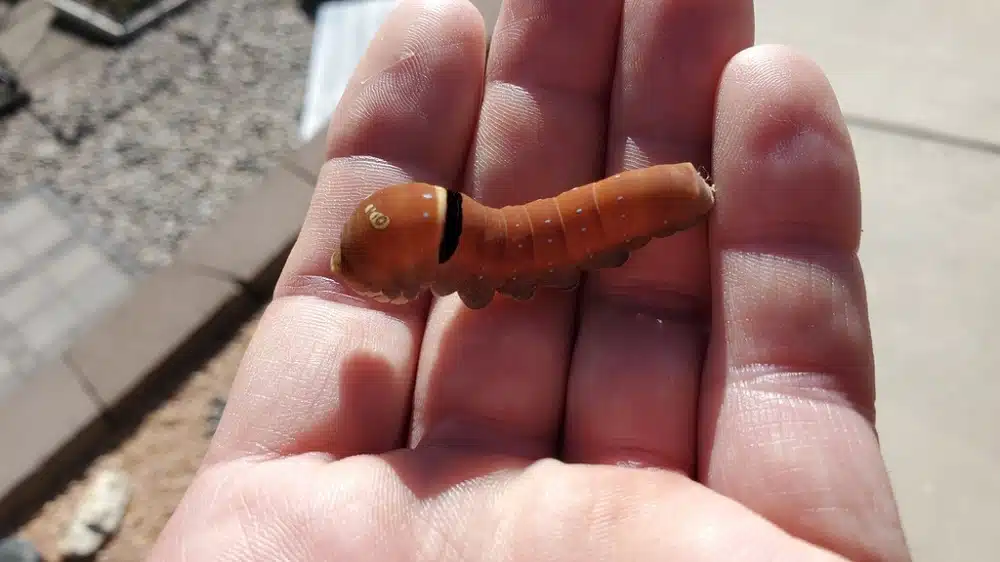
This species of caterpillars (Papilio multicaudata) are seen next to woodlands, in moist areas, and at low elevations next to slopes.
The caterpillar feeds on ash and chokeberry. The leaves of the host are rarely impacted to a high extent to cause health problems to the tree.
The initial yellow color is specific to this host. This color then becomes brown and white as the caterpillar grows.
It transforms from a yellow caterpillar into a brown and white caterpillar that mimics bird droppings.
The transformation process takes the caterpillar into a vivid green growth stage followed by an orange-brown growth stage before it finally darkens.
Thistles and milkweed are among the most common nectar sources for the emerged Two-tailed Swallowtail butterfly.
21. Hubbard’s Silk Moth Caterpillar
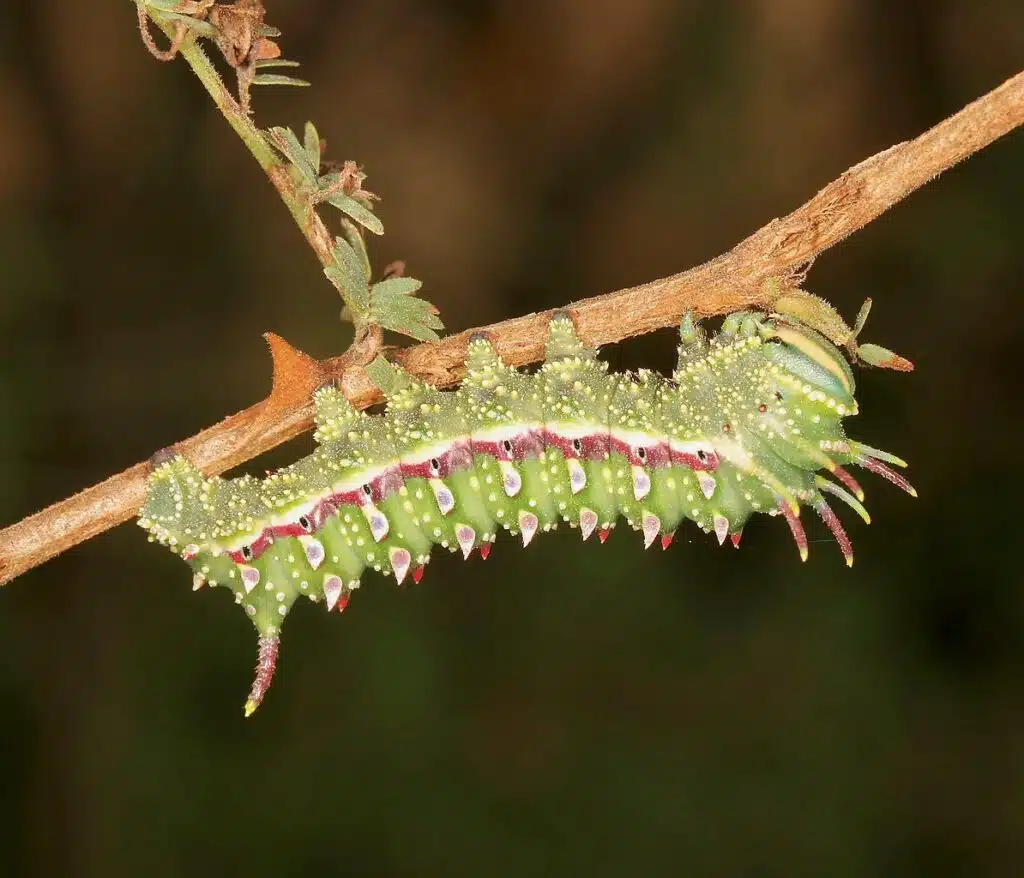
Several broods of Hubbard’s Silk Moth Caterpillars (Syssphinx hubbardi) are seen in the state.
The season of the species lasts from May to early November.
Hubbard’s Silk Moth Caterpillars like to feed on different types of acacia plants across the state.
They have adapted their body to look mildly poisonous.
Unlike most other green caterpillars, Hubbard’s Silk Moth Caterpillars also have white and red spikes of various lengths on the dorsal side.
These spikes aren’t visible on the early instar caterpillar.
Feeding is the primary concern of the caterpillar during the day as the species stops feeding once the adult moth has emerged.
22. Carolina Sphinx Caterpillar
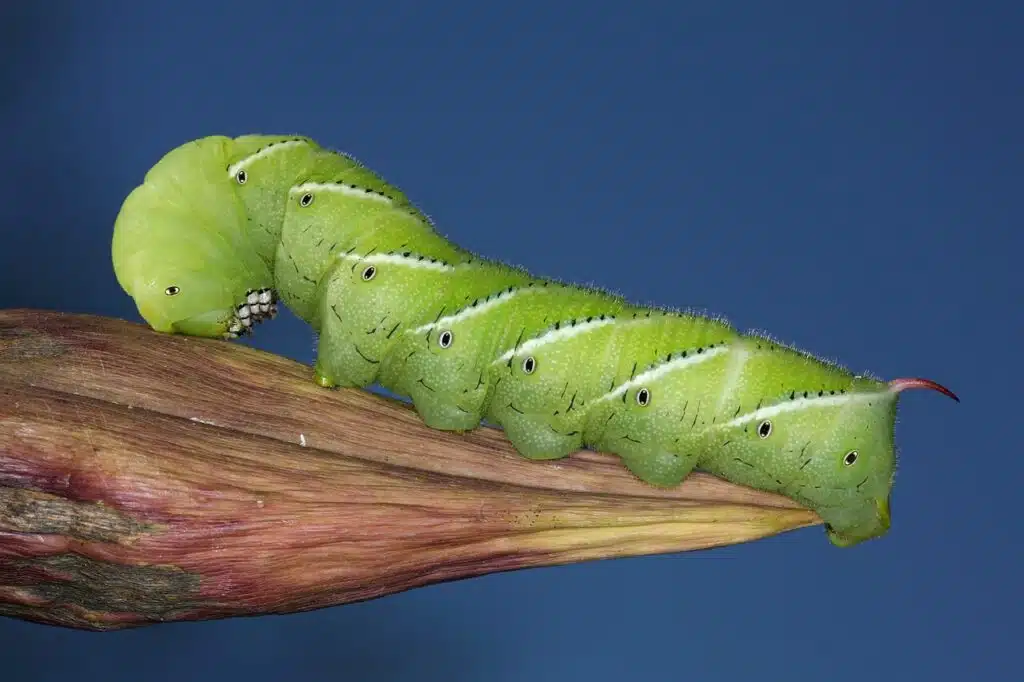
Some of the most damaging types of caterpillars in Arizona are Carolina Sphinx Caterpillars (Manduca sexta).
While not as common as other species, these caterpillars have a base green color with diagonal white stripes on both sides.
The species is among the few that feeds on potatoes, tomato, and tobacco.
Ornamental flowers are among the species adult moths feed on, in turn. Petunias and honeysuckle are some of the most common nectar sources for moths of the species.
The season of the species is long, with most damages being seen in late supper.
Carolina Sphinx Caterpillars remain active until October.
Management techniques involve the use of deterring chemicals.
Also known as the Tobacco Hornworms, these types of caterpillars are mostly managed by tobacco plantations.
23. Red-spotted Admiral Caterpillar
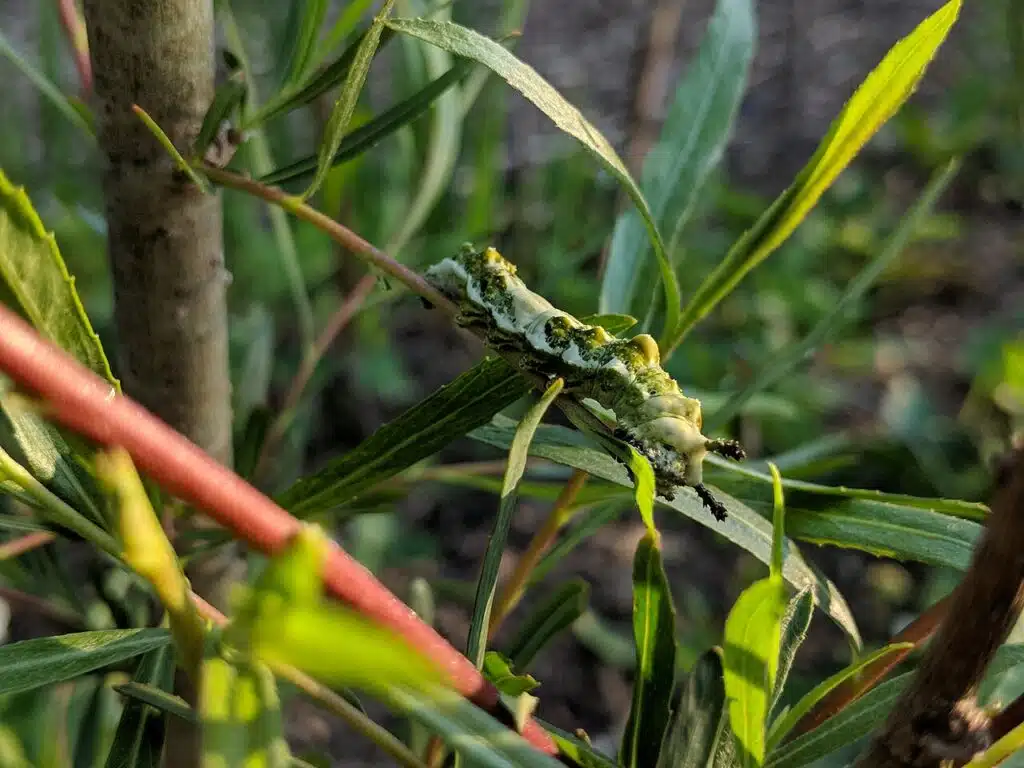
Black cherry is the main host of the Red-spotted Admiral Caterpillar (Limenitis arthemis) followed by different types of willow.
To a lesser extent, Red-spotted Admiral caterpillars also feed on the leaves of various trees such as cottonwood and black oak.
These caterpillars mimic bird droppings. Their multicolored body aims to keep them safe in front of potential predators.
2 to 3 broods are seen each year across the state.
Spending up to a few weeks in its caterpillar stage, this species later turns into a chrysalis which also mimics bird droppings.
This species is considered a minor problem for the Arizona ecosystem as it’s found in a considerably reduced population as opposed to other states such as Texas or California.
24. Mourning Cloak Caterpillar
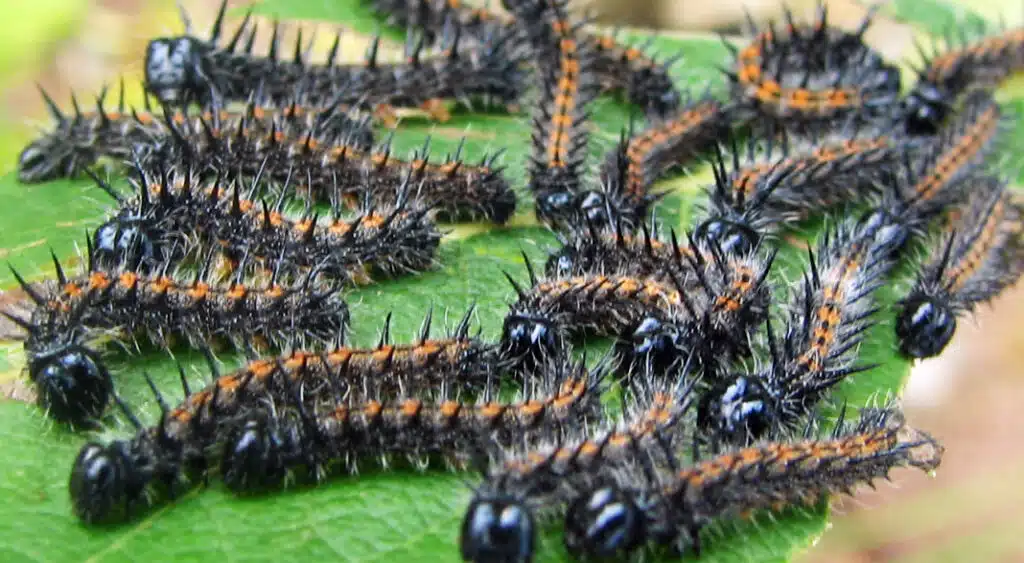
Mourning Cloaks (Nymphalis antiopa) are a species dominated by dark colors through all of their life stages.
This is a species that has dark brown to black colorings like a butterfly and a black color with tiny white dots like a caterpillar.
Black spikes and large brown spots are further spotted on the dorsal side of this caterpillar.
Growing to a maximum length of 2 inches, this species then becomes smaller as it moves into a chrysalis.
Willows are among the common hosts of the caterpillar.
Other trees might also be suitable hosts for the species in the absence of willow. Hackberries are among its alternative hosts.
25. Staghorn Cholla Moth Caterpillar
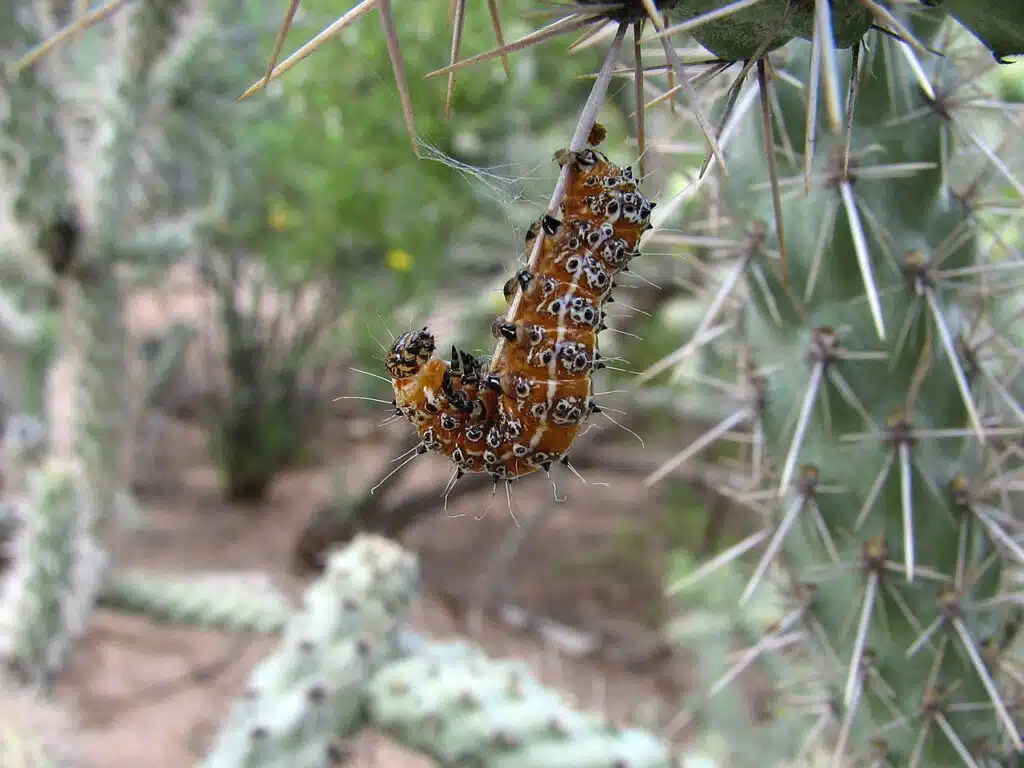
This type of caterpillar (Euscirrhopterus cosyra) has a rare light brown-caramel color.
It uses cactuses in Arizona, New Mexico, and Texas as host plants.
Unlike other caterpillars that feed on the inner parts of cacti, the Staghorn Cholla Moth Caterpillar feeds on the outer part of cactuses.
Only found in Southern regions of Arizona and further South in Baja California, this species has multiple broods each year.
Its season starts in May and lasts until October.
Those looking to see the caterpillar in its natural habitat are most likely to find it on buckhorn cholla in the Southern regions of the state.
This is one of the most common types of cactuses in Southern Arizona.
26. Black Swallowtail Caterpillar
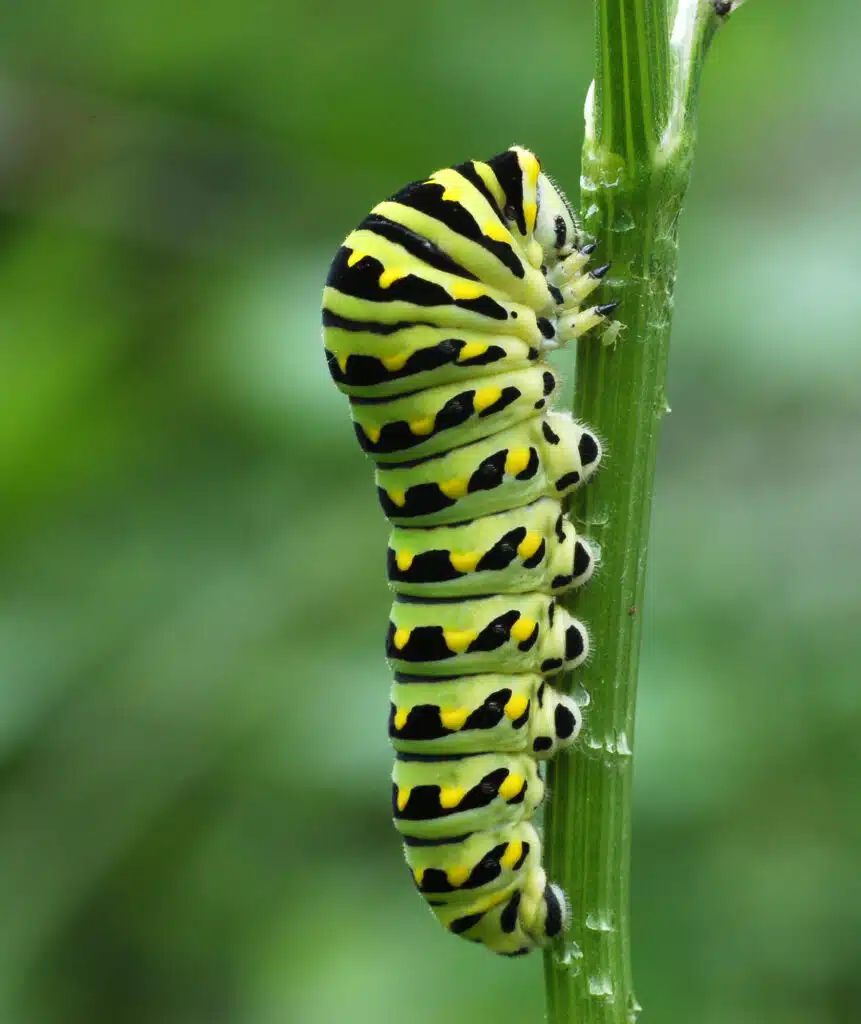
Black Swallowtail Caterpillars (Papilio polyxenes) are only black in their early growth stages.
These caterpillars have a black color with orange dots at the base of black spikes.
As they grow, Black Swallowtail Caterpillars turn green. Black bands across the body with yellow spots are also characteristic of the late instar caterpillars.
Different types of plants and flowers are the hosts of the species around prairies, arid climates, gardens, or in parks.
Fennel, honewort, waterparsnip, and even parsley can be its hosts.
The species turns into a green chrysalis afterward.
Much of the location of these caterpillars is dictated by the mating location of the adult butterflies. Males maintain territories by asserting aggression.
27. Black Witch Caterpillar
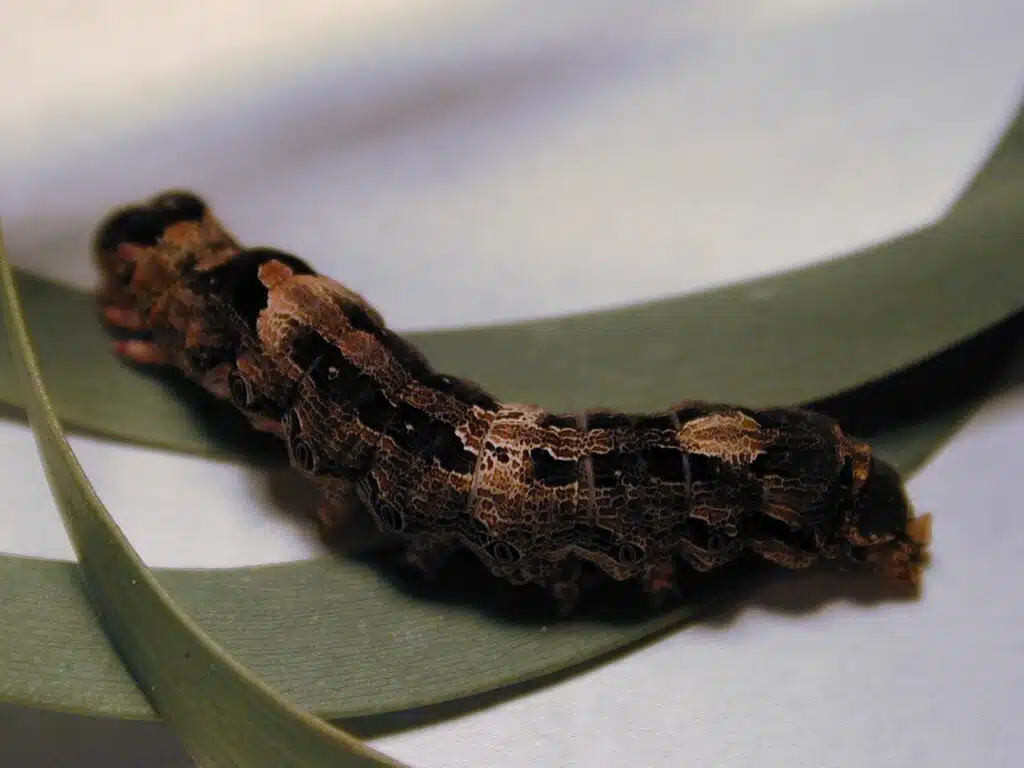
Black Witch Caterpillars (Ascalapha odorata) are among the most damaging species in the state. This species is rarely seen in high numbers to cause considerable economic losses or to impact its costs considerably.
You can identify this species by its base black color with brown dorsal spots.
The leaves of its host trees tend to be the most impacted when it comes to direct damage.
Black Witch Caterpillars are spotted on acacia, coffeetree, and mesquites among other species.
A nocturnal species, the caterpillar has a considerably larger impact on the ecosystem South of Arizona in Mexico where it’s associated with tree death.
28. Purslane Moth Caterpillar
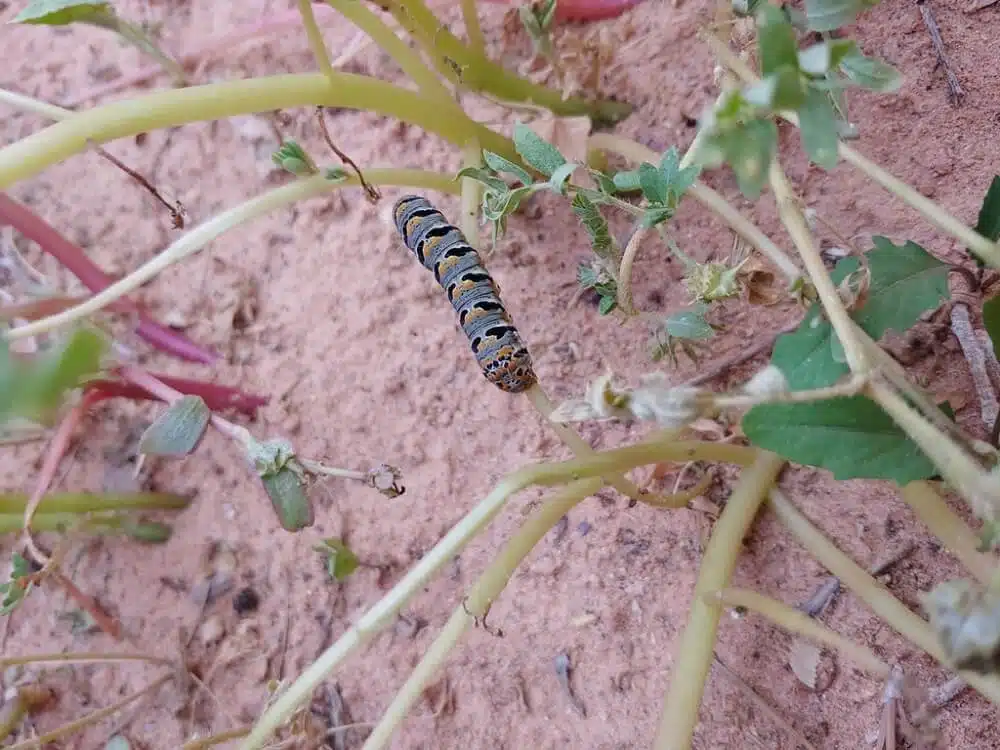
Some of the most atypical caterpillars in Arizona in terms of colors are Purslane Moth Caterpillars (Euscirrhopterus gloveri).
White is the dominant color of the species with considerable white areas inherited by the emerged moth of the species.
Purslane Moth Caterpillars have a base white color with black dorsal stripes.
Yellow or orange dots are seen on the central section of the black crossbands on the species.
A species adapted to desert
climates, Purslane Moth Caterpillars are a species that feeds on small leaf shrubs and plants.
Common Purslane is one of its typical hosts. The plant has small circular green leaves the caterpillar eats the edges off.
29. American Lady Caterpillar
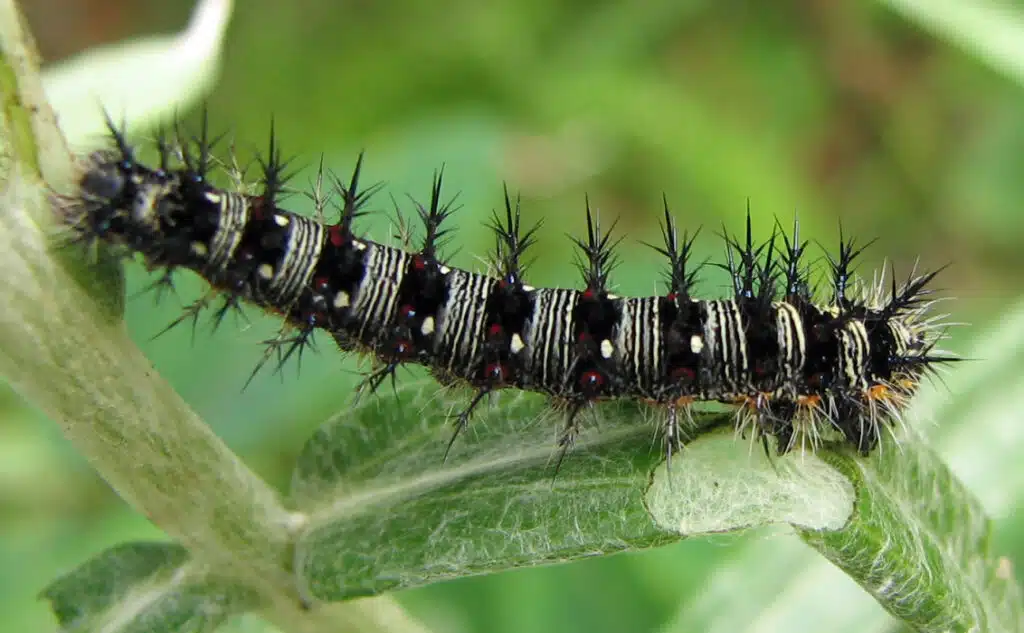
A rare sight in Arizona, American Lady Caterpillars (Vanessa virginiensis) immediately stand out whenever they grow on plants in the state.
They create a silk-like wrap around the plant for protection and this means they feed differently from most other caterpillars in Arizona.
Herbs are among the host plants the caterpillars use for food and wrap in silk.
Everlasting is the common herb of the American Lady Caterpillar.
Sweet everlasting and other subspecies of this plant are also among its most common hosts.
A dark caterpillar, the American Lady Caterpillar eventually grows to become a black species with fine yellow parallel crossbands.
30. Silver-spotted Skipper Caterpillar
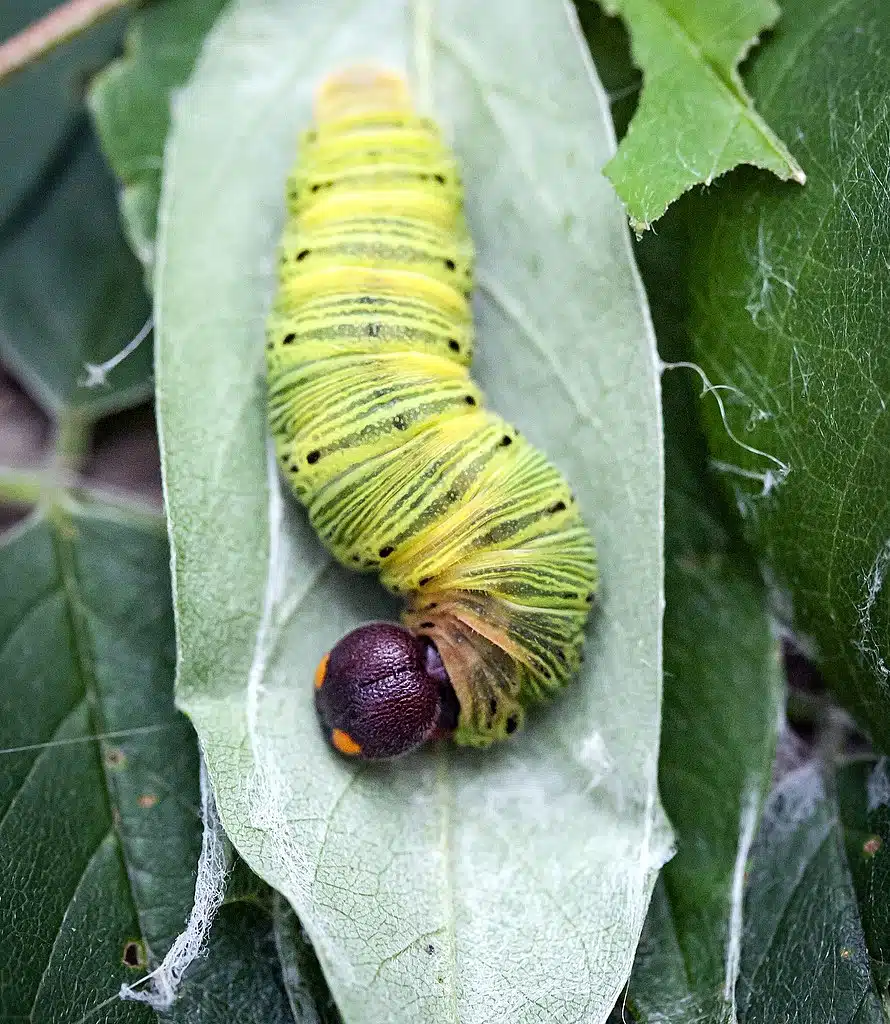
Silver-spotted Skipper Caterpillars (Epargyreus clarus) are among the few species which always have the potential for outbreaks but which rarely cause a major impact.
This is a species that can invade soy crops and which may also invade kidney bean vines eating the leaves of the vines and killing the plant.
In most years, the low numbers of these caterpillars mean farmers in Arizona have no reasons to worry about them.
Different types of vines such as The American hodgepeanut are the main hosts of the species.
These caterpillars may also be seen on blooming trees with long flowers such as wisteria.
Caterpillars of this family are characterized by vivid yellow coloring and a large brown head. These colors don’t make the species any better in terms of camouflage as with other green caterpillars.
31. Mylitta Crescent Caterpillar
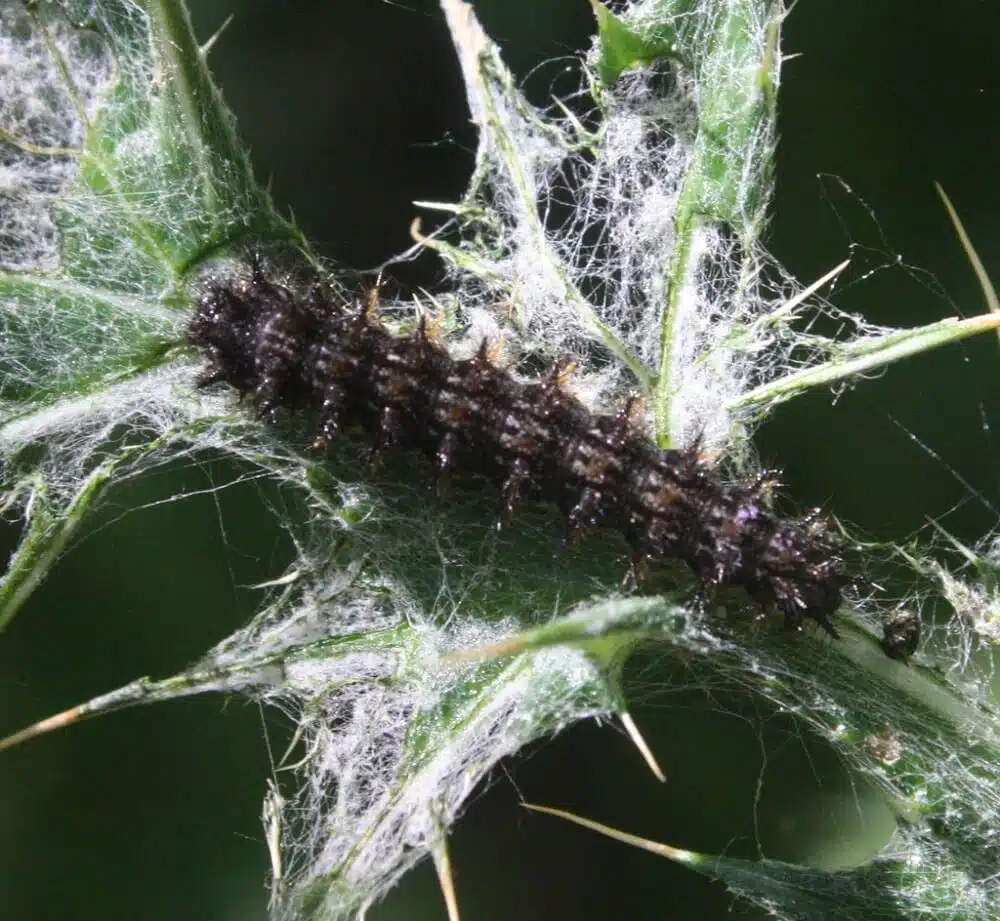
Mylitta Crescent Caterpillars (Phyciodes mylitta) have one of the longest seasons in the state.
This species makes its appearance in early February and it remains active until the fall.
A dark appearance based on black and brown nuances is specific to the dorsal and ventral sides of this caterpillar.
White or yellow lateral stripes further contrast the dark body of this caterpillar as it grows.
If adults prefer flower nectar, Mylitta Crescent Caterpillars are only interested in plant leaves.
Thistles such as Milk thistles are its preferred plant hosts.
Up to 4 broods of Mylitta Crescent Caterpillars are seen each year.
32. Tomato Hornworm
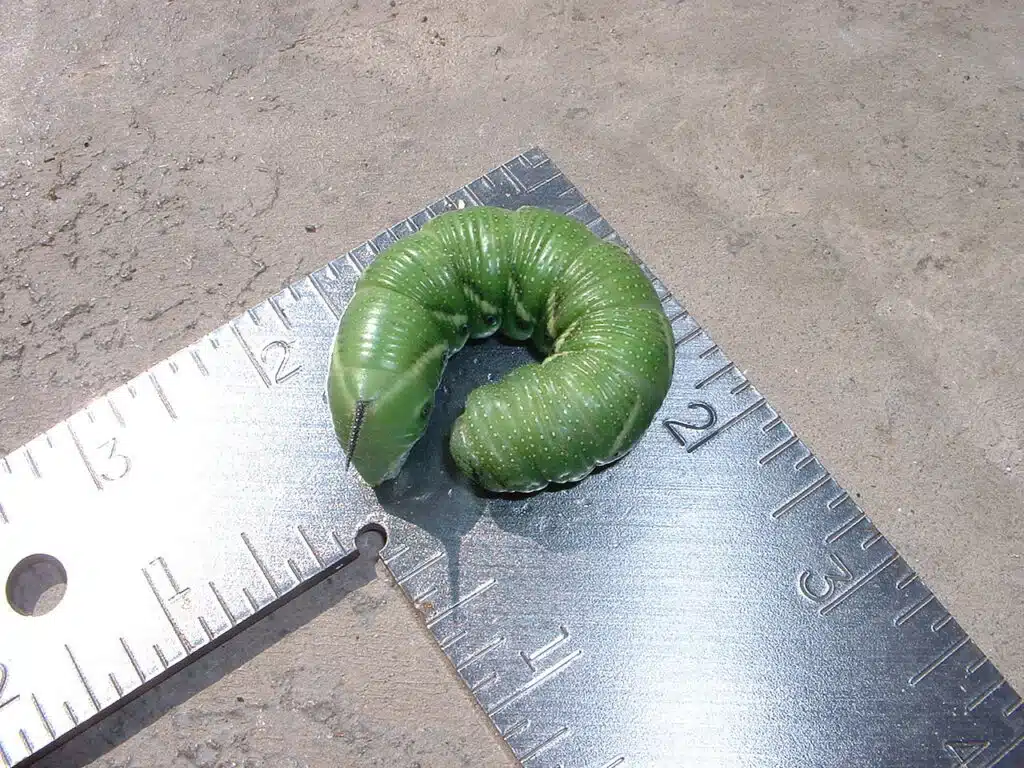
Tomato Hornworms (Manduca quinquemaculatus) are some of the most pest caterpillars on tomato crops, wild tobacco, eggplant, and potato.
The pest status of the species may be considered elsewhere but it remains low in Arizona due to a low number of caterpillars seen each year, mostly towards the end of the summer.
Appearance-wise, the caterpillar is easily confused with other species as it has a common green color with white or yellow diagonal lateral stripes.
Orange dots on the sides become larger orange spots on the sides of the caterpillar into its later growth stages.
This species eats a large number of leaves and stems. It can also be seen moving from one plant to another whenever food resources are scarce.
Cultivated plants tend to be the most affected.
33. Western Poplar Sphinx Caterpillar
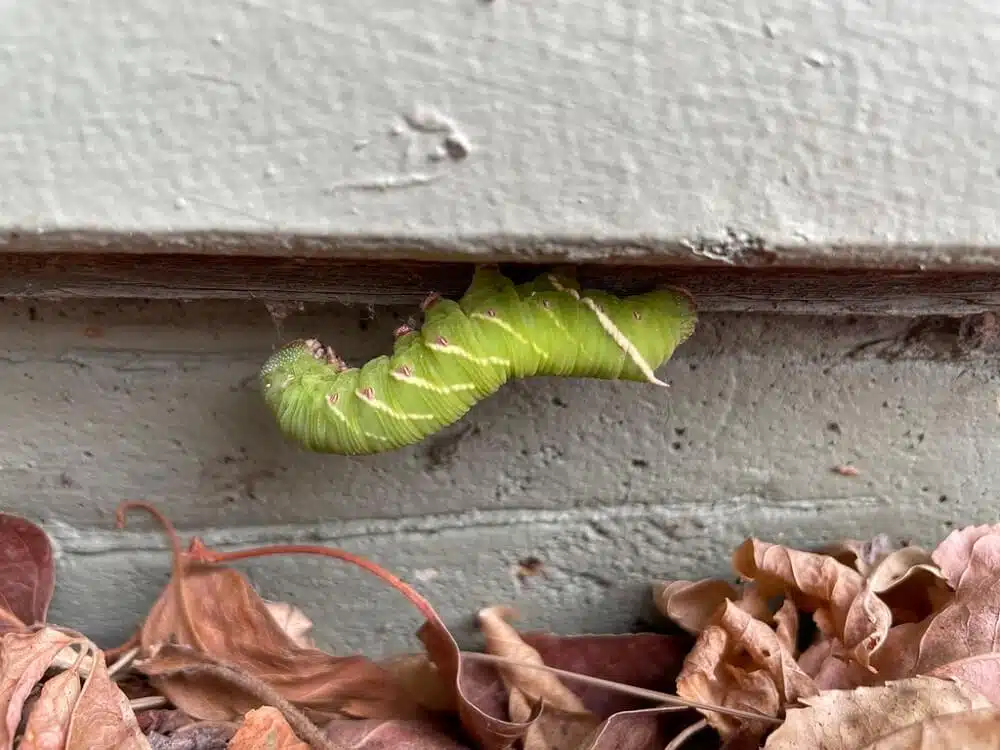
Western Poplar Sphinx Caterpillars (Pachysphinx occidentalis) also need to be monitored for their possible impact on poplar in Southern parts of Arizona.
Only 2 broods of this species are seen each year in the state.
The Western Poplar Sphinx Caterpillar makes its appearance later in the year, towards the end of May. It also has a short season that ends in August or September.
This species begins life as a cream-colored egg.
It turns into a green caterpillar with long yellow stripes on its back.
A short brown band is seen on the back of its anal plate. Faint diagonal yellow lines may also be spotted on the sides of the species.
34. Red Admiral Caterpillar
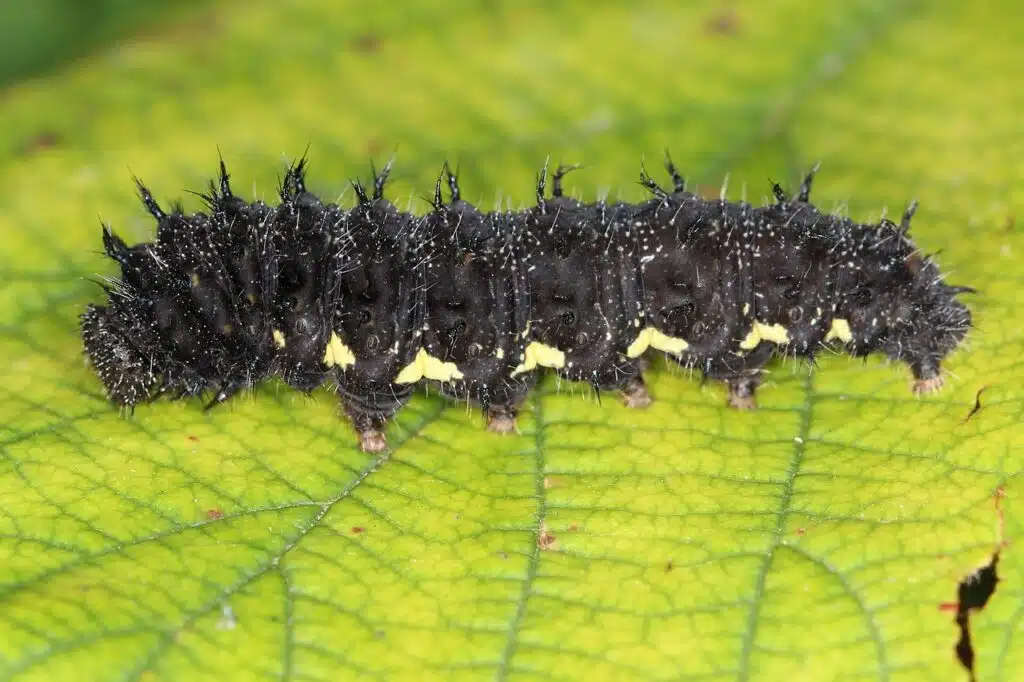
Some Red Admiral Caterpillars (Vanessa atalanta) may be spotted in Arizona. These are the caterpillars from laid eggs that haven’t made it to Southern Texas.
It’s in Texas that the Red Admiral Caterpillar is migrating for overwintering.
2 to 3 broods of Red Admiral Caterpillars may be spotted in the summer.
This is a species dominated by black coloring with black spines.
Red Admiral Caterpillars brighten to a dark brown color in their final instar. Black spines remain black in their last growth stage.
Collective migration from habitats in the North influence the number of Red Admiral Caterpillars in the state.
While rare, the Red Admiral Caterpillar can be spotted on stinging nettle in Arizona.